- Introduction
- The Significance of the Amazon Sacred Headwaters Region
- Threats to the Sacred Headwaters
- The Amazon Sacred Headwaters Initiative: Goals and Strategies
- Indigenous Leadership: Protecting the Land & Heritage
- Conclusion
- FAQs
- References
Introduction
The Amazon Sacred Headwaters Initiative (ASHI) is a major conservation project focusing on one of Earth's most biodiverse and ecologically significant regions. It's an effort aimed at preserving the headwaters of the Amazon River, which span across parts of Ecuador and Peru. In this article, we'll explore the immense importance of this region, the threats it faces, the aims of the initiative, the role of Indigenous leadership in its protection, and more.
We’ll also delve into how ASHI’s strategies aim to balance socio-economic needs with environmental preservation, ensuring the survival of a unique ecosystem and the communities that depend on it.
Read on to discover the intricate connections between protecting the Amazon heartland and global climate health, while looking deeper into the multi-faceted approach this initiative employs to achieve its mission.
The Significance of the Amazon Sacred Headwaters Region

(Image: Pixabay/@deltreehd)
The Amazon Sacred Headwaters region holds a key position in the global ecological web. Situated in the upper Amazon basin, predominantly across Ecuador and northeastern Peru, this area comprises both rivers and pristine tropical rainforests. These ecosystems form the foundation for the entire Amazon River system, supplying it with vital freshwater resources.
The region is home to over 3 million hectares of primary forest. Not only does this place harbor tens of thousands of species of plants and animals, many still undiscovered by science, but it also supports several Indigenous communities. These groups maintain a deep connection with their land, relying on it for food, medicine, and cultural practices.
This area plays a significant role in moderating the world's climate. The Amazon as a whole acts as a massive carbon sink, absorbing CO2 from the atmosphere. Additionally, the clouds and mist generated by this dense forest release moisture into circulation, influencing rainfall patterns far beyond South America.
Were the headwaters to degrade, the environmental consequences would stretch much further than local habitats or even regional ecosystems. The destabilization of this region could accelerate climate change on a global scale.
Threats to the Sacred Headwaters

(Image: Pixabay/@Skitterphoto)
Despite its ecological value, the Sacred Headwaters region faces numerous anthropogenic threats. Chief among these is the relentless advance of industrial activities. Rainforests are being cleared for oil exploration, logging, farming, and industrial development. The construction of new roads to facilitate these enterprises only exacerbates deforestation and habitat fragmentation.
Oil extraction in particular poses a serious risk. Ecuador and Peru, both rich in natural resources, have licensed large portions of these unique ecosystems for oil drilling. The consequences are complex; pollution not only threatens wildlife but also endangers the water sources that Indigenous communities rely upon.
Open-pit mining is another destructive force in the region. Mining activities leach mercury, arsenic, and other deadly chemicals into rivers, contaminating waterways. In doing so, they directly threaten all life forms reliant on clean water, from fish to human communities downstream.
Climate change intensifies these threats, introducing external stressors such as higher temperatures and unpredictable storm patterns. The increased presence of arid conditions leads to forest fires, drying out what were once lush areas of the basin and hampering their ability to act as carbon sinks.
The Amazon Sacred Headwaters Initiative: Goals and Strategies

(Image: Pixabay/@Michael_Fotofreund)
Born out of necessity, the Amazon Sacred Headwaters Initiative (ASHI) was established through a collaboration of Indigenous federations and conservation organizations to halt the destruction of this critical area. The ambition is not just about stopping deforestation but about full-scale ecosystem recovery and long-term sustainability.
Key goals include establishing an interconnected "biocultural" corridor throughout Ecuador and Peru to ensure a continuous stretch of protected land. This aims to preserve biodiversity while respecting the regions’ Indigenous peoples' spiritual and territorial sovereignty.
ASHI seeks to show that there are alternatives to extractivism. Sustainable economic models such as ecotourism, agroforestry, and bioeconomy endeavors like harvesting non-timber forest resources provide pathways for economic prosperity without sacrificing ecological integrity.
Additionally, the Initiative focuses on influencing policy and advocating for changes in national and international regulations. By actively engaging governments, the Initiative pushes to end further oil and gas concessions in sensitive regions and secure legal rights for Indigenous groups.
Indigenous Leadership: Protecting the Land & Heritage

(Image: Pixabay/@Ponciano)
At the heart of the Amazon Sacred Headwaters Initiative is the commitment to recognize Indigenous peoples as the stewards of their territories. Indigenous leadership is key in ASHI's overall strategy to safeguard the environment—after all, these communities have sustainably managed lands for millennia.
Different Indigenous tribes such as the Achuar, Kichwa, Shuar, Sápara, and others hold territories within this region and have led countless resistance movements against exploitative endeavors. For them, the forest, the rivers, and the land go beyond resources; they are essential to their spirituality, culture, and survival.
The Sacred Headwaters Initiative actively supports and respects Indigenous governance by amplifying their voices in decision-making processes. Tribal leaders collaborate with national and international groups to establish Indigenous-led conservation agendas and co-manage protected areas.
The initiative fosters initiatives that center human well-being and tribal rights alongside environmental conservation. With programs like legal capacity-building to help these communities defend their land titles in courts, ASHI ensures that future development aligns with their heritage and long-standing connection to the earth.
Conclusion
The Amazon Sacred Headwaters Initiative represents a crucial stand against ecological destruction and corporate greed while promoting people-friendly, lucrative alternatives to extractive industries. Rooted deeply in Indigenous knowledge and leadership, this effort underscores the critical need for global solidarity in protecting the remaining frontiers of our shared, life-giving planet.
By sustaining ecosystems and cultures, ASHI not only helps mitigate global climate crisis effects but also preserves incredible biodiversity for future generations.
FAQs
What countries does the Amazon Sacred Headwaters Initiative cover?
The Amazon Sacred Headwaters Initiative spans across sections of Ecuador and Peru, targeting the upper reaches of the Amazon River Basin.
Why are the Sacred Headwaters important?
This region is home to invaluable biodiversity, including species not found anywhere else. It’s essential for global climate regulation and provides crucial resources for Indigenous peoples.
How do industrial activities affect the Amazon headwaters?
Industrial activities like oil drilling and gold mining disrupt habitats and pollute waterways, causing lasting damage to local ecosystems and Indigenous communities.
What makes Indigenous leadership vital in this initiative?
Indigenous peoples have been stewards of these lands for centuries, and their knowledge and relationship with the environment are integral to effective conservation efforts.

